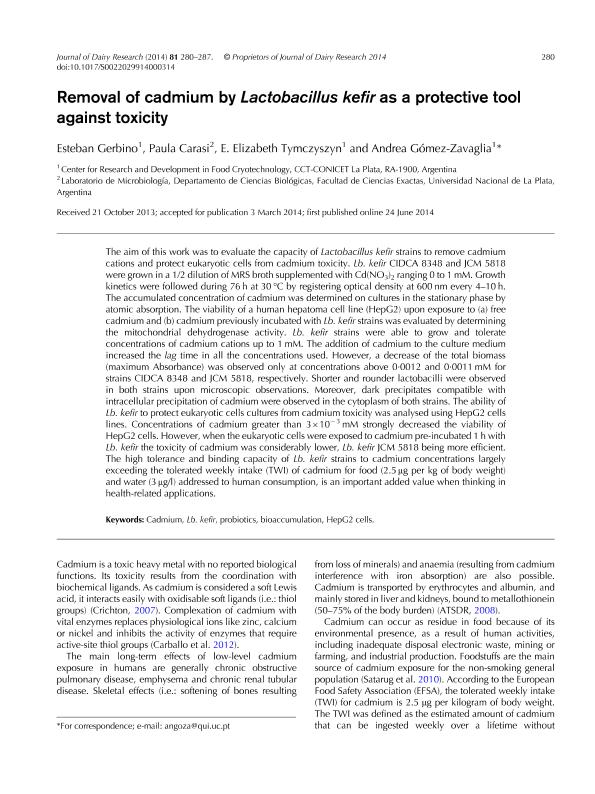Mostrar el registro sencillo del ítem
dc.contributor.author
Gerbino, Oscar Esteban

dc.contributor.author
Carasi, Paula

dc.contributor.author
Tymczyszyn, Emma Elizabeth

dc.contributor.author
Gomez Zavaglia, Andrea

dc.date.available
2018-01-03T18:48:07Z
dc.date.issued
2014-03
dc.identifier.citation
Gomez Zavaglia, Andrea; Tymczyszyn, Emma Elizabeth; Carasi, Paula; Gerbino, Oscar Esteban; Removal of cadmium by Lactobacillus kefir as a protective tool against toxicity; Cambridge University Press; Journal of Dairy Research; 81; 3; 3-2014; 280-287
dc.identifier.issn
0022-0299
dc.identifier.uri
http://hdl.handle.net/11336/32165
dc.description.abstract
The aim of this work was to evaluate the capacity of Lactobacillus. kefir strains to remove cadmium cations and protect eukaryotic cells from cadmium toxicity. Lb. kefir CIDCA 8348 and JCM5818 were grown in a 1/2 dilution of MRS broth supplemented with Cd(NO3)2 ranging 0 to 1 mM. Growth kinetics were followed during 76 hours at 30 °C by registering optical density at 600 nm every 4-10 hours. The accumulated concentration of cadmium was determined on cultures in the stationary phase by atomic absorption. The viability of a human hepatoma cell line (HepG2) upon exposure to a) free cadmium and b) cadmium previously incubated with Lb. kefir strains was evaluated by determining the mitochondrial dehydrogenase activity. Lb. kefir strains were able to grow and tolerate concentrations of cadmium cations up to 1 mM. The addition of cadmium to the culture medium increased the lag time in all the concentrations used. However, a decrease of the total biomass (maximum Absorbance) was observed only at concentrations above 0.0012 and 0.0011 mM for strains CIDCA 8348 and JCM 5818, respectively. Shorter and rounder lactobacilli were observed in both strains upon microscopic observations. Moreover, dark precipitates compatible with intracellular precipitation of cadmium were observed in the cytoplasm of both strains. The ability of Lb. kefir to protect eukaryotic cells cultures from cadmium toxicity was analysed using HepG2 cells lines. Concentrations of cadmium greater than 3x10-3 mM strongly decreased the viability of HepG2 cells. However, when the eukaryotic cells were exposed to cadmium pre-incubated 1 h with Lb. kefir the toxicity of cadmium was considerably lower, Lb. kefir JCM 5818 being more efficient. The high tolerance of Lb. kefir strains to cadmium concentrations largely exceeding the tolerated levels of cadmium for food (2.5 ug per kg of body weight) and water (3 ug/l) addressed to human consumption, is an important added value when thinking in health-related applications. Moreover, the protective effect on HepG2 cells supports the regular administration of Lb. kefir as an adequate and easy to implement strategy to prevent the harmful effects of cadmium in populations exposed to this toxic metal.
dc.format
application/pdf
dc.language.iso
eng
dc.publisher
Cambridge University Press

dc.rights
info:eu-repo/semantics/openAccess
dc.rights.uri
https://creativecommons.org/licenses/by-nc-sa/2.5/ar/
dc.subject
Lactobacillus Kefir
dc.subject
Cadmium
dc.subject
Probiotics
dc.subject
Bioaccumulation
dc.subject
Hepg2 Cells
dc.subject.classification
Otras Ciencias Biológicas

dc.subject.classification
Ciencias Biológicas

dc.subject.classification
CIENCIAS NATURALES Y EXACTAS

dc.subject.classification
Bioremediación, Diagnóstico Biotecnológico en Gestión Medioambiental

dc.subject.classification
Biotecnología del Medio Ambiente

dc.subject.classification
INGENIERÍAS Y TECNOLOGÍAS

dc.subject.classification
Otras Ciencias Biológicas

dc.subject.classification
Ciencias Biológicas

dc.subject.classification
CIENCIAS NATURALES Y EXACTAS

dc.title
Removal of cadmium by Lactobacillus kefir as a protective tool against toxicity
dc.type
info:eu-repo/semantics/article
dc.type
info:ar-repo/semantics/artículo
dc.type
info:eu-repo/semantics/publishedVersion
dc.date.updated
2017-12-26T14:32:28Z
dc.journal.volume
81
dc.journal.number
3
dc.journal.pagination
280-287
dc.journal.pais
Reino Unido

dc.journal.ciudad
Cambridge
dc.description.fil
Fil: Gerbino, Oscar Esteban. Provincia de Buenos Aires. Gobernación. Comisión de Investigaciones Científicas. Centro de Investigación y Desarrollo en Criotecnología de Alimentos. Consejo Nacional de Investigaciones Científicas y Técnicas. Centro Científico Tecnológico Conicet - La Plata. Centro de Investigación y Desarrollo en Criotecnología de Alimentos. Universidad Nacional de La Plata. Facultad de Ciencias Exactas. Centro de Investigación y Desarrollo en Criotecnología de Alimentos; Argentina
dc.description.fil
Fil: Carasi, Paula. Universidad Nacional de la Plata. Facultad de Ciencias Exactas. Departamento de Ciencias Biológicas. Cátedra de Microbiología General; Argentina. Consejo Nacional de Investigaciones Científicas y Técnicas; Argentina
dc.description.fil
Fil: Tymczyszyn, Emma Elizabeth. Provincia de Buenos Aires. Gobernación. Comisión de Investigaciones Científicas. Centro de Investigación y Desarrollo en Criotecnología de Alimentos. Consejo Nacional de Investigaciones Científicas y Técnicas. Centro Científico Tecnológico Conicet - La Plata. Centro de Investigación y Desarrollo en Criotecnología de Alimentos. Universidad Nacional de La Plata. Facultad de Ciencias Exactas. Centro de Investigación y Desarrollo en Criotecnología de Alimentos; Argentina
dc.description.fil
Fil: Gomez Zavaglia, Andrea. Provincia de Buenos Aires. Gobernación. Comisión de Investigaciones Científicas. Centro de Investigación y Desarrollo en Criotecnología de Alimentos. Consejo Nacional de Investigaciones Científicas y Técnicas. Centro Científico Tecnológico Conicet - La Plata. Centro de Investigación y Desarrollo en Criotecnología de Alimentos. Universidad Nacional de La Plata. Facultad de Ciencias Exactas. Centro de Investigación y Desarrollo en Criotecnología de Alimentos; Argentina
dc.journal.title
Journal of Dairy Research

dc.relation.alternativeid
info:eu-repo/semantics/altIdentifier/url/https://www.cambridge.org/core/journals/journal-of-dairy-research/article/removal-of-cadmium-by-lactobacillus-kefir-as-a-protective-tool-against-toxicity/3F63EBD1ED932724B657621F93D52F4D
dc.relation.alternativeid
info:eu-repo/semantics/altIdentifier/doi/https://doi.org/10.1017/S0022029914000314
Archivos asociados
